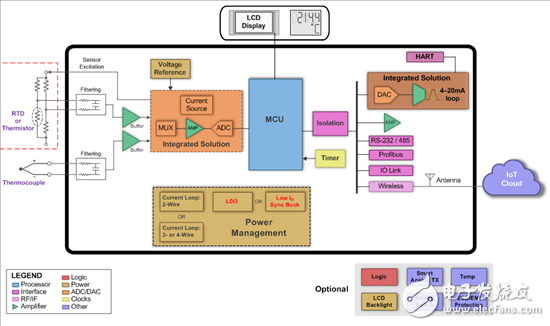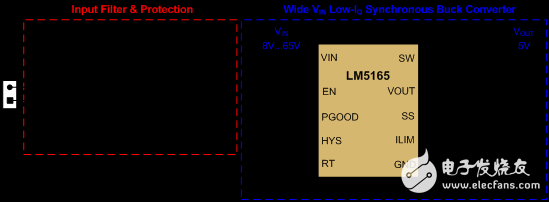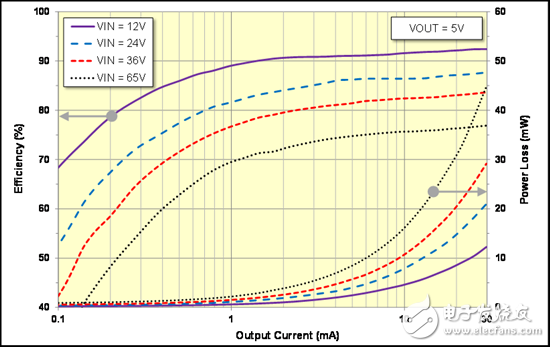Smart sensor transmitters are widely used in factory automation, production process instrumentation and control equipment to measure temperature, pressure, flow, level and many other process variables. Figure 1 is a block diagram of a field transmitter that uses a resistive temperature detector (RTD), thermistor, or thermocouple to measure the main variables.

Figure 1: Block diagram of a temperature transmitter for process control applications
The signal chain includes a sensor analog front end, a microcontroller (MCU), and high-precision analog-to-digital converters and digital-to-analog converters.
Relies on a 4-20mA loop to power smart sensors
Although the basic sensor transmitter circuit MCUs and data converters are often optimized for low operating currents, the increased functionality in high-performance smart sensor applications has led to increased current demand. For example: Current consumption will be greater when the circuit includes features such as isolation, calibration and diagnostics, an LCD display interface, or wireless connectivity options such as Bluetooth Low Energy or Wireless HART.
Such smart sensor systems will probably not be able to meet the typical under-scale current limit of 4-20mA loop or 4mA zero-scale current level. For example, the default loop currents that calibrate the low error and high error currents of the TI DAC161S997 are 3.375mA and 21.75mA, respectively. The NAMUR NE43 specification has similar current thresholds. Fortunately, a high-efficiency synchronous buck converter can provide a higher output current than the low-dropout regulator to power the sensor electronics while collecting less than 3.375mA from the loop.
Wide VIN, Low IQ Synchronous Buck Converter
For charging the sensor, the LM5165 synchronous step-down solution provided by TI has high efficiency and ultra-low quiescent current (IQ = 10.5μA). Because it operates with a 20:1 wide input voltage (VIN) range and is capable of withstanding repeated 65V surges, its output voltage is tolerant of large noise voltage swings at the input. This immunity to transients is critical in sensor applications that require high reliability.
Input Filter and Protection Wide VIN Low IQ Synchronous Buck Converter

Figure 2: Pulse-Frequency Modulation (PFM) Synchronous Step-Down Converter Schematic, Including an EMC Filter and Protection Circuit
Figure 2 shows the converter schematic for a 5V/25mA output configuration. Adding an input filter with reverse polarity and transient/surge voltage protection helps to achieve electromagnetic compatibility (EMC).
Various features for smart sensor applications built into the LM5165 include a simple control architecture for optimal solution size, 100% duty cycle capability for low dropout, one for rail sequencing and fault reporting Open-drain power good indication circuit, internally fixed or externally adjustable soft start (SS), and high precision enable with customizable hysteresis to provide programmable line undervoltage lockout (UVLO) functionality. Also, an adjustable cycle-by-cycle current limit optimizes inductor selection and size. Figure 3 shows the converter efficiency and power dissipation for a 0.1mA to 30mA load current.

Positioning of Wide VIN, Low IQ Step-Down Converters
The advantage of a wide VIN buck converter, such as the LM5165, is its consistent set of features that meet the needs of a specific set of power supply solutions:
High efficiency synchronous buck design can be achieved over a wide range of load currents.
Improved reliability (rated operating junction temperature up to 150°C)
A wide VIN range with sufficient headroom can safely withstand input voltage transient disturbances, thus allowing the use of a higher voltage (and smaller footprint) transient suppressor diode (TVS).
The small solution size is suitable for space-constrained sensor housings.
The input capacitance is reduced to meet the requirements of an intrinsically safe (IS) application environment.
The active slew rate control of the switch mode voltage reduces the high frequency conduction and radiated EMI characteristics.
To take full advantage of the potential of a new loop-powered sensor transmitter and maintain a simple two-wire architecture, a low IQ synchronous buck converter provides sufficient load current while meeting current loops, solution size, Reliability and EMC requirements.
What`s the main features appear into your mind when you look yoga laptop? Lightweight, super thinner, touch screen, 360 rotating, smaller size, like as notebook? You are right, that`s the main reasons why some people also called it as laptop yoga slim or yoga notebook. To OS, just same as Education Laptop-windows operating system, so you can see many windows yoga laptop at the market around the world. In fact, this intel yoga laptop usually is designed for normal jobs, like basic WPS, Photoshop, video or music editing, online learning, shopping, presentation when on a business trip, etc. At our store, you can see 11.6 inch n5100 360 Laptop in metal, 13.3 inch 360 flip laptop, and 14 inch 360 degree rotating laptop, etc. The people who take business trips often or prefer fashion design should like this type device.
There are education laptop also, like 14.1 inch Student Laptop for Hope or government Projects, 15.6 inch competitive celeron business laptop for normal business works, 15 inch 10th or 11th Gaming Laptop for heavier tasks, like teachers, high or university students, etc, 16.1 inch i7 16gb ram 4gb graphics laptop for engineering student, etc
Any other question or other requirements, just contact us freely.
Yoga Laptop,Laptop Yoga Slim,Yoga Notebook,Intel Yoga Laptop,Windows Yoga Laptop
Henan Shuyi Electronics Co., Ltd. , https://www.shuyioemminipc.com